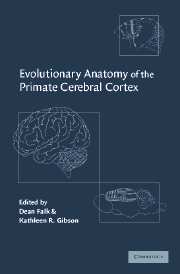Book contents
- Frontmatter
- Contents
- List of contributors
- Preface
- Prologue: Size matters and function counts
- Part I The evolution of brain size
- Introduction to Part I
- 1 Encephalization and its developmental structure: how many ways can a brain get big?
- 2 Neocortical expansion and elaboration during primate evolution: a view from neuroembryology
- 3 In defense of the Expensive Tissue Hypothesis
- 4 Bigger is better: primate brain size in relationship to cognition
- 5 The evolution of sex differences in primate brains
- 6 Brain evolution in hominids: are we at the end of the road?
- Part II Neurological substrates of species-specific adaptations
- Epilogue: The study of primate brain evolution: where do we go from here?
- Index
Introduction to Part I
Published online by Cambridge University Press: 07 October 2011
- Frontmatter
- Contents
- List of contributors
- Preface
- Prologue: Size matters and function counts
- Part I The evolution of brain size
- Introduction to Part I
- 1 Encephalization and its developmental structure: how many ways can a brain get big?
- 2 Neocortical expansion and elaboration during primate evolution: a view from neuroembryology
- 3 In defense of the Expensive Tissue Hypothesis
- 4 Bigger is better: primate brain size in relationship to cognition
- 5 The evolution of sex differences in primate brains
- 6 Brain evolution in hominids: are we at the end of the road?
- Part II Neurological substrates of species-specific adaptations
- Epilogue: The study of primate brain evolution: where do we go from here?
- Index
Summary
Jerison's now classic volume, Evolution of the Brain and Intelligence (1973), drew inspiration from the words of Karl Lashley
The only neurological character for which a correlation with behavioral capacity in different animals is supported by significant evidence is the total mass of tissue, or rather, the index of cephalization, measured by the ratio of brain to body weight, which seems to represent the amount of brain tissue in excess of that required for transmitting impulses to and from the integrative centers.
(Lashley, 1949, p. 33, cited Jerison, 1973, p. 3.)Jerison expanded Lashley's views in key respects. First, he postulated that brain size is a natural biological statistic that can be readily used to estimate other anatomical characteristics of the brain including the size of other neural structures, the degree of fissurization, and neuronal density. He recognized, however, one major exception to this rule – the size of the olfactory bulbs appears to have little relationship to that of other brain structures. Second, Jerison articulated the principle of proper mass – ‘the mass of neural tissue controlling a particular function is appropriate to the amount of information processing involved in performing the function.’ (Jerison, 1973, p. 8). Third, Jerison recognized that brain mass varies with body mass, and he developed a model of brain/body size relationships according to which, with increasing body size, brain size expands in a mathematically predictable way in each vertebrate class.
- Type
- Chapter
- Information
- Evolutionary Anatomy of the Primate Cerebral Cortex , pp. 3 - 13Publisher: Cambridge University PressPrint publication year: 2001
- 1
- Cited by



